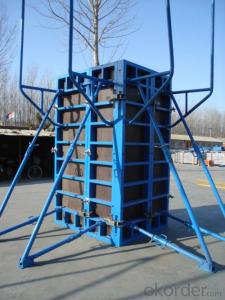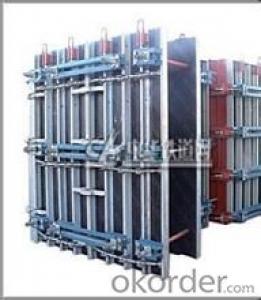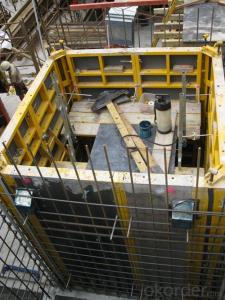COLUMN 120 STEEL FRAMED FORMWORK FOR LIFTS CONSTRUCTION
- Loading Port:
- Shanghai
- Payment Terms:
- TT OR LC
- Min Order Qty:
- 1000 m²
- Supply Capability:
- 100000 m²/month
OKorder Service Pledge
OKorder Financial Service
You Might Also Like
1. Structure of 120 Steel Framed Formwork Description
Single-side bracket is a kind of formwork for the concrete pouring of single-side wall. The construction is easy and fast. The components have good standard performance and versatility. The pouring height is adjustable, the maximum height of a single pouring is 8.9m.The formwork is always used in the concrete pouring of basement, subway, Sewage treatment factory and so on. The waterproof of the finished wall is excellent
2. Main Features of 120 Steel Framed Formwork
-easy to assemble
-simple structure.
-and convenient for transportation
-convenient for storage.
3. 120 Steel Framed Formwork Images
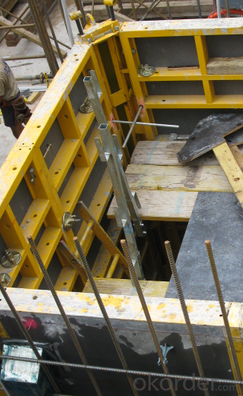
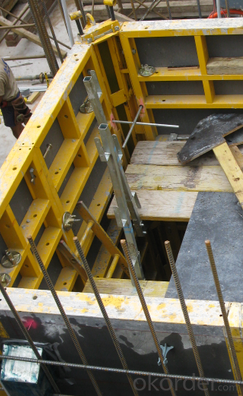
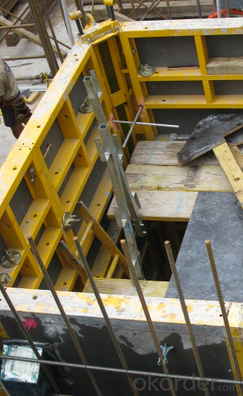
4. Single-side Steel Framed Formwork Specifications
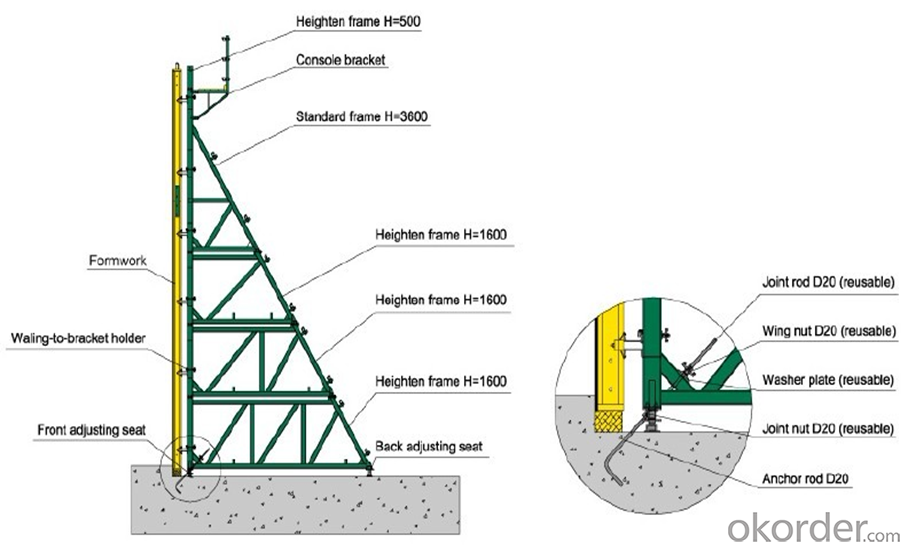
5.FAQ of 120 Steel Framed Formwork
1) What can we do for you?
.We can ensure the quality of the 120 steel framed formwork and avoid extra expenses for customers.
.We can provide you the professional technical team.
.We can provide professional building proposal for your project.
. Please feel free to customize.
2) What promises can be done by us?
. If interested in single side steel framed formwork, please feel free to write us for any QUOTE.
. If need any technical and building assistance, we could provide on-site professional staff for instruction.
. Please DO check goods when courier knocks your door and contact us asap if any issueS.
3) What about of our after-sale service?
. Response will be carried out in 24hours after receiving any complain or request.
. Single side steel framed formwork cost can be refund after order is confirmed.
. If the products are not based on the requirements, there will be the relevant compensations made for you.
4) What about the package and shipping time?
.Packing: wood package and
.Shipping: by sea
Shipping time: Normally small orders, it just1week business days to arrive your hand; When comes to the customs declaration, it may need 2 weeks.
- Q:Can steel frame formwork be used for airport and transportation infrastructure construction?
- Indeed, airport and transportation infrastructure construction can utilize steel frame formwork. This construction system, known for its versatility and durability, proves to be appropriate for various project types, including large-scale infrastructure endeavors like airports and transportation facilities. By employing steel frame formwork, a robust and stable structure is established for concrete pouring, guaranteeing the resulting construction's strength and ability to endure the demands of heavy traffic and frequent use. The steel frames are easily assembled and disassembled, enabling efficient construction and reducing downtime. Moreover, steel frame formwork offers design flexibility and can be tailored to meet specific project requirements. This aspect is particularly crucial for airport and transportation infrastructure construction, as these establishments often possess distinctive architectural and structural needs. Furthermore, steel frame formwork exhibits remarkable durability, allowing it to withstand the challenging conditions commonly associated with airports and transportation infrastructure, such as severe weather and heavy loads. Consequently, it stands as an ideal choice for constructing long-lasting and dependable facilities within these sectors. Overall, steel frame formwork proves to be a suitable choice for airport and transportation infrastructure construction due to its strength, versatility, and durability. It furnishes the necessary structural support and flexibility required for such projects, ensuring the successful completion of high-quality and resilient facilities.
- Q:How does steel frame formwork compare to timber formwork in terms of cost?
- In terms of cost, steel frame formwork generally tends to be more expensive compared to timber formwork. This is mainly due to the higher material and manufacturing costs associated with steel. Steel frame formwork requires the use of steel beams, panels, and other components, which are typically more expensive than timber materials. Additionally, constructing steel formwork requires specialized skills and equipment, which can further increase the overall cost. On the other hand, timber formwork is relatively more affordable as timber materials are generally cheaper and readily available. However, it is important to note that despite its initial higher cost, steel frame formwork offers several advantages that can contribute to cost savings in the long run. Steel formwork is more durable and has a longer lifespan compared to timber formwork, which can result in reduced maintenance and replacement costs over time. Moreover, the reusability of steel formwork is another cost-saving factor. Steel frames can be easily dismantled, transported, and reused for multiple construction projects, whereas timber formwork may need to be replaced after a few uses due to wear and tear. Ultimately, when considering the cost of formwork, it is essential to evaluate the specific needs and requirements of the project, as well as the expected lifespan and potential for reuse. While steel frame formwork may initially have a higher price tag, its durability and reusability can make it a more cost-effective choice in the long term, particularly for larger or repetitive projects. Conversely, timber formwork may be more suitable for smaller or one-time projects where cost efficiency is a primary concern.
- Q:How does steel frame formwork accommodate for different concrete pouring techniques?
- The steel frame formwork system is versatile and adaptable, making it suitable for various concrete pouring techniques. Its design allows for customization options, making it a great choice for a wide range of construction projects. To accommodate different concrete pouring techniques, the steel frame formwork system utilizes adjustable panels and modular components. These panels can be easily repositioned and adjusted to create different shapes and sizes, providing flexibility in the pouring technique. Whether it's a simple straight wall or a complex curved structure, the steel frame formwork can be adjusted accordingly. In addition, the steel frame formwork system often includes various accessories and attachments that can be used to further customize the pouring technique. These accessories, such as adjustable supports, tie rods, and clamps, provide additional stability and reinforcement to the formwork, ensuring it can withstand the pressure and weight of the concrete during pouring. Furthermore, the steel frame formwork system is known for its high load-bearing capacity and durability. This allows it to accommodate different pouring techniques, including high-density concrete or rapid pouring, without compromising its integrity. The strength and stability of the steel frame formwork ensure it can handle the increased pressure and weight associated with different pouring techniques. In conclusion, the steel frame formwork system accommodates different concrete pouring techniques through its adjustable panels, modular components, accessories, and high load-bearing capacity. Its versatility allows for customization and adaptability, making it the preferred choice for construction projects that require flexible pouring techniques.
- Q:Can steel frame formwork be used for both above-grade and below-grade concrete structures?
- Yes, steel frame formwork can be used for both above-grade and below-grade concrete structures. Steel frame formwork is a versatile and flexible solution that can be customized to fit various project requirements. It provides a strong and rigid support system for pouring and shaping concrete, ensuring accurate and precise construction. Whether it is for above-grade structures like buildings and bridges or below-grade structures like basements and tunnels, steel frame formwork is a reliable choice that can withstand the pressure of the concrete and provide a safe and stable construction process.
- Q:The following is a two storey steel frame to be done above the door of the frame of 9 meters high, with the PKPM model is the use of door type rigid frame, with interlayer, or the lower frame, the upper
- Not suitable for separate calculation, it is recommended to use the spatial model analysis. Such as MADIS, 3D3S
- Q:How does steel frame formwork contribute to the overall fire resistance of a structure?
- Steel frame formwork contributes to the overall fire resistance of a structure in several ways. Firstly, steel is known for its high melting point and excellent heat resistance. This means that it can withstand high temperatures for longer periods of time before it starts to lose its structural integrity. In the event of a fire, the steel frame formwork acts as a barrier, protecting the structure from the direct heat of the flames and preventing the spread of fire to other parts of the building. Additionally, steel frame formwork has the ability to retain its strength even at elevated temperatures. This is crucial in maintaining the structural stability of the building during a fire. Unlike other construction materials, such as wood or concrete, steel does not weaken or lose its load-bearing capacity when exposed to high temperatures. This ensures that the structure remains intact and reduces the risk of collapse. Moreover, steel is non-combustible, meaning it does not ignite or contribute fuel to a fire. This characteristic further enhances the fire resistance of the structure as it helps to contain the fire within a specific area and prevents it from spreading to other parts of the building. By confining the fire to a limited space, steel frame formwork allows for easier and safer evacuation of occupants and provides more time for firefighting efforts. Furthermore, steel frame formwork is often used in conjunction with fire-resistant materials, such as fire-resistant insulation and fire-rated coatings. These additional measures enhance the fire resistance of the structure by providing an extra layer of protection against the heat and flames. The combination of steel frame formwork and fire-resistant materials creates a robust fire-resistant system that significantly improves the overall fire safety of the building. In conclusion, steel frame formwork contributes to the overall fire resistance of a structure by providing a strong and heat-resistant barrier, retaining its load-bearing capacity at high temperatures, being non-combustible, and working in tandem with fire-resistant materials. By incorporating steel frame formwork into the construction process, the risk of fire-related damage and the potential for loss of life can be greatly reduced.
- Q:Can steel frame formwork be used in projects with limited construction resources or equipment?
- Steel frame formwork is a practical choice for projects with limited construction resources or equipment. It is a versatile and durable solution for creating concrete structures, requiring minimal equipment and resources for installation and operation. Compared to traditional timber formwork, steel frame formwork offers several advantages in terms of strength, stability, and reusability. Steel frames are highly rigid, capable of withstanding greater pressures, allowing for the construction of taller and more complex structures. Additionally, steel formwork systems are easily assembled and dismantled, reducing the need for specialized equipment and labor. The reusability of steel formwork further enhances its suitability for projects with limited resources. Unlike timber formwork, which is often discarded after a few uses, steel formwork can be used multiple times, reducing overall costs and material wastage. Furthermore, steel formwork provides a consistent and uniform finish to concrete structures, ensuring high-quality construction results. This is particularly beneficial for projects with limited resources, as it eliminates the need for additional finishing work or repairs. In conclusion, steel frame formwork is a practical option for projects with limited construction resources or equipment. Its strength, stability, reusability, and ease of installation make it a cost-effective and efficient solution for creating concrete structures in such circumstances.
- Q:Can steel frame formwork be used in projects with complex architectural designs?
- Yes, steel frame formwork can be used in projects with complex architectural designs. Steel frame formwork is a versatile and flexible system that can be customized to meet the specific requirements of complex architectural designs. It can be easily adjusted and modified to create various shapes, angles, and curves, making it suitable for projects that demand intricate and unique designs. Steel frame formwork provides a strong and durable structure that can withstand the pressures and forces exerted during the concrete pouring process. It offers excellent stability and support, ensuring that complex architectural designs are accurately formed and maintained. The steel frame formwork system allows for precise alignment and positioning of formwork elements, which is crucial for achieving complex shapes and patterns. Furthermore, steel frame formwork is highly adaptable and can be easily reconfigured or modified to accommodate changes in architectural designs during the construction process. This flexibility enables architects and engineers to experiment with different design elements and make adjustments as needed without compromising the structural integrity of the formwork system. In addition to its adaptability, steel frame formwork offers several other advantages such as high reusability, quick assembly and dismantling, and reduced labor and material costs. These factors make it a cost-effective solution for projects with complex architectural designs. Overall, steel frame formwork is a suitable choice for projects with complex architectural designs due to its versatility, strength, flexibility, and cost-effectiveness. It provides the necessary support and stability while allowing for creative freedom and customization, making it an ideal formwork system for such projects.
- Q:How does steel frame formwork address issues of concrete cracking and spalling?
- Steel frame formwork addresses issues of concrete cracking and spalling in several ways. Firstly, steel frame formwork provides a rigid and stable structure to support the weight of the fresh concrete during the casting and curing process. This eliminates any movement or shifting of the formwork, which can lead to uneven concrete surfaces and potential cracking. Secondly, steel frame formwork allows for precise and accurate placement of reinforcement bars and ensures proper alignment. This helps to distribute the load evenly, reducing the chances of localized stress concentrations that can cause cracking or spalling. Additionally, steel frame formwork provides a smooth and uniform surface finish, reducing the likelihood of air voids or weak spots in the concrete. This helps to prevent moisture ingress and the subsequent freeze-thaw cycle that can cause spalling. Furthermore, steel frame formwork can be easily adjusted and modified to accommodate different shapes and sizes of concrete elements. This flexibility allows for the proper placement of additional reinforcement where required, further enhancing the structural integrity of the concrete and minimizing the risk of cracking or spalling. Overall, the use of steel frame formwork in concrete construction helps to address issues of concrete cracking and spalling by providing a stable, accurate, and well-supported framework for the concrete, resulting in a durable and high-quality finished product.
- Q:How does steel frame formwork handle different types of formwork sealing techniques?
- Steel frame formwork is a versatile and robust system that can handle different types of formwork sealing techniques effectively. The steel frame provides strength and stability to the formwork structure, ensuring that it can withstand the pressure exerted by the concrete during pouring and curing. When it comes to formwork sealing techniques, steel frame formwork offers several advantages. Firstly, it provides a rigid and tight structure that prevents any leakage of concrete. This is particularly important when using liquid or flowable concrete mixes. The steel frame ensures that the formwork remains intact and there are no gaps or spaces where the concrete can escape. Secondly, steel frame formwork allows for the use of various sealing materials and techniques. For example, rubber gaskets or seals can be used to create a watertight seal between the formwork and the structure. These gaskets are usually placed along the joints and edges of the formwork to prevent any water or concrete from seeping through. Additionally, steel frame formwork can accommodate the use of waterstops, which are materials placed within the formwork joints to prevent water penetration. These waterstops are typically made from rubber or PVC and are effective in preventing any water leakage. Furthermore, steel frame formwork can also incorporate the use of tie rods and formwork ties to ensure a secure and tight seal. These components are used to hold the formwork panels together tightly, preventing any movement or displacement during concrete pouring. This helps to maintain the integrity of the formwork, ensuring that it can handle different sealing techniques. In summary, steel frame formwork is well-equipped to handle different types of formwork sealing techniques. Its strength and stability provide a solid structure that can resist the pressure exerted by the concrete. Additionally, the flexibility of the steel frame allows for the use of various sealing materials and techniques, ensuring a watertight and secure formwork system.
1. Manufacturer Overview |
|
|---|---|
| Location | |
| Year Established | |
| Annual Output Value | |
| Main Markets | |
| Company Certifications | |
2. Manufacturer Certificates |
|
|---|---|
| a) Certification Name | |
| Range | |
| Reference | |
| Validity Period | |
3. Manufacturer Capability |
|
|---|---|
| a)Trade Capacity | |
| Nearest Port | |
| Export Percentage | |
| No.of Employees in Trade Department | |
| Language Spoken: | |
| b)Factory Information | |
| Factory Size: | |
| No. of Production Lines | |
| Contract Manufacturing | |
| Product Price Range | |
Send your message to us
COLUMN 120 STEEL FRAMED FORMWORK FOR LIFTS CONSTRUCTION
- Loading Port:
- Shanghai
- Payment Terms:
- TT OR LC
- Min Order Qty:
- 1000 m²
- Supply Capability:
- 100000 m²/month
OKorder Service Pledge
OKorder Financial Service
Similar products
New products
Hot products
Related keywords
